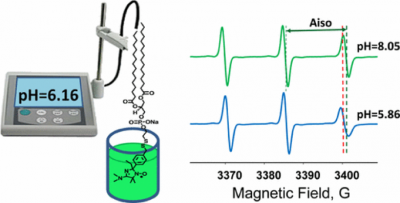pH-Sensitive Headgroup-Modified Lipids as Molecular Probes of Bilayer Electrostatic Potential and Effective Dielectric Constant

 Surface electrostatic potential of cellular membranes is known to be directly involved in regulating numerous vital functions of living cells. Currently, probing of local electrostatic interactions and dielectric properties of the interfacial contacts remains to be challenging even for the modern spectroscopic methods. In order to address these challenges Smirnov lab is developing pH-sensitive phospholipids that have ionizable nitroxides tethered directly to the lipid polar head and associated EPR methods to measure surface electrostatic potential of lipid bilayers. EPR spectra of such bilayer electrostatic probes (see Figure below) directly report on its ionization state through changes in nitroxide magnetic parameters and the degree of rotational averaging. The shift in pKa of the probe is determined by local dielectric constant, ε, and the electrostatic potential. A linear relationship between the probe pKa and ε has been established and found to be essentially temperature independent. Next, the polarity term contributing to the pKa of IKMTSL-PTE at an uncharged lipid-like interface was determined by incorporating the probe into electrically neutral micelles formed from nonionic detergent Triton X-100. Such experiments allowed for measuring effective ε and the surface bilayer electrostatic potential right at the bilayer interface, thus, expanding analytical capabilities of EPR beyond vaguely defined “polarity” profiles.
Surface electrostatic potential of cellular membranes is known to be directly involved in regulating numerous vital functions of living cells. Currently, probing of local electrostatic interactions and dielectric properties of the interfacial contacts remains to be challenging even for the modern spectroscopic methods. In order to address these challenges Smirnov lab is developing pH-sensitive phospholipids that have ionizable nitroxides tethered directly to the lipid polar head and associated EPR methods to measure surface electrostatic potential of lipid bilayers. EPR spectra of such bilayer electrostatic probes (see Figure below) directly report on its ionization state through changes in nitroxide magnetic parameters and the degree of rotational averaging. The shift in pKa of the probe is determined by local dielectric constant, ε, and the electrostatic potential. A linear relationship between the probe pKa and ε has been established and found to be essentially temperature independent. Next, the polarity term contributing to the pKa of IKMTSL-PTE at an uncharged lipid-like interface was determined by incorporating the probe into electrically neutral micelles formed from nonionic detergent Triton X-100. Such experiments allowed for measuring effective ε and the surface bilayer electrostatic potential right at the bilayer interface, thus, expanding analytical capabilities of EPR beyond vaguely defined “polarity” profiles.
- Voinov, M. A.; Smirnov, A. I. Meth Enzym 2015, 564, 219.
- Voinov, M. A.; Kirilyuk, I. A.; Smirnov, A. I. J Phys Chem B 2009, 113, 3453.
- Voinov, M. A.; Scheid, C. T.; Kirilyuk, I. A.; Trofimov, D. G.; Smirnov, A. I. J Phys Chem B 2017, 121, 2443.
